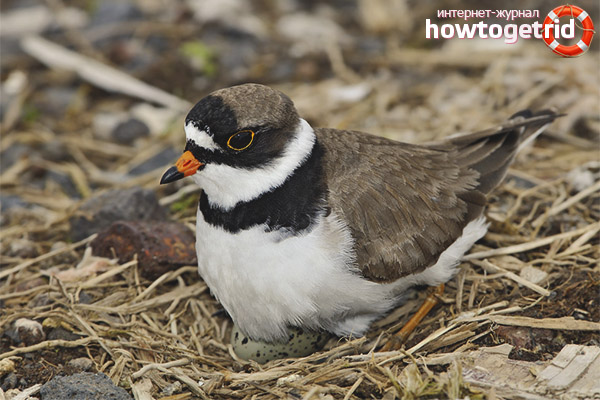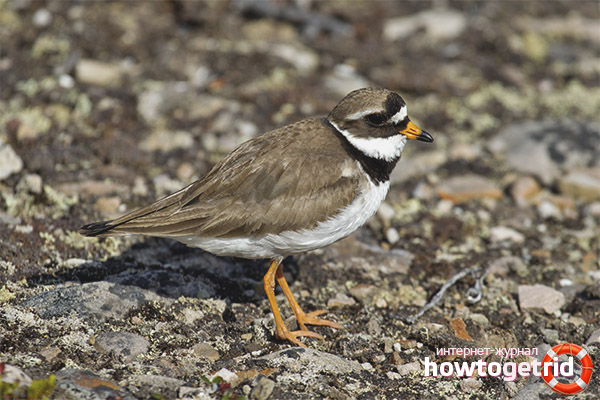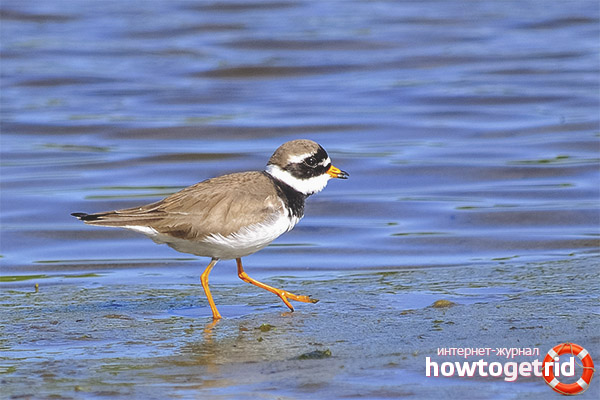The content of the article
A tie is a small, nimble and slightly funny bird with a characteristic color in the neck. The triangular black collar resembles a tied tie, which gave the bird its name. Tie belongs to the charadriiformes family, a bird of the genus Zuika. In appearance, the tie is small, slightly larger than the sparrow. You can meet a tiny mischief on small river pebbles, off the coasts of small reservoirs and seas. In this article we will find out what a tie looks like, where it lives and what is interesting for a person.
Tie Description
The length of the body of a tie is usually not more than 20 cm, the wingspan is not more than half a meter, the weight is only 50-60 grams. The upper part of the plumage of the bird is gray, brown or brown, the lower part is white. On the head of the tie through the eyes passes a black stripe that resembles a mask to many. The base of the beak and paws of the tie are bright orange. During the flight, a long white stripe is visible from the inside of the wing. In winter, during the flight, the color of the bird may change - the back becomes more brown and smoky, the beak loses its orange color, becomes faded and dull. The female practically does not differ in color from the male, with the exception of the color of the "blindfold" on her eyes. In the male, this strip has a deep black tint, while in the female it is slightly lighter, more likely brown or gray. In addition, males, as usual, are larger than their ladies.
Tie Habitat
Tie propagation

The relationship between the male and the female tie can be considered ideal. This is a great example of how both parents are involved in raising, feeding and protecting chicks. Birds of this species are monogamous, choose a pair once for life. It often happens that during the winter the couple is separated, since each of them flies in different directions. However, in the spring, during the breeding season, future parents reunite. As a rule, females arrive earlier from wintering and in a week the male arrives. Constancy is characteristic not only in pairing, but also in arranging nests.Having built a nest once, neckties will use it all their life or until it is suitable for hatching offspring. After the reunion of the female and the male, mating games begin, which last at least two weeks - the birds actively "flow" at this time.
As a rule, a male builds a nest. He makes a deepening in soft sandy soil or finds an existing hole (most often, this is a footprint from a hoof). The bottom of the future nest is lined with mollusks or shells. When the nest is ready, the female begins to lay eggs - about one in every 2-3 days. On average, 4 eggs per clutch. The surface of the eggs is gray or brown with a large number of interspersed. Thus, it is very difficult to notice eggs in pebbles or sand. Hatch eggs for about a month, both parents do this, periodically replacing each other at the post. After the chicks hatch, they need about three more weeks to grow stronger and stand on the wing. As soon as this happens, the couple prepares to set aside the second clutch. As a rule, if all offspring survive, two clutches are usually enough for parents. If the nests were devastated by birds of prey or amphibians, ties in the struggle for procreation postpone up to 5 clutches during the breeding season. Moreover, not all chicks survive and learn to independently get their own food - this is possible only by the strongest, smartest and strongest. On average, only a third of the chicks become adults and survive in natural conditions.
Interesting Ties
The world of some species of birds reveals a lot of interesting details to a person, and a tie is no exception.
- Sometimes it happens that an educated couple breaks up - if one of the partners dies during the winter, etc. So, if the female or male did not return from wintering, the second partner will violently defend the common nest and will not allow someone from other birds to take it.
- Ties, like other bunnies, are very cunning. To drive the uninvited guest away from the nest, the bird will pretend to be wounded and will begin to attract the enemy to the other side from the masonry. But as soon as the predator moves away to a safe distance, the tie will fly off.
- If the nest is no longer suitable for use, ties try to build a “new house” in close proximity to the old dwelling.
- Sometimes a male can build false nests to attract the attention of a female - that is, for visibility.
- The nesting period of a tie is on average about 100 days.
- In the UK, neckties are protected as one of the rare and amazing birds that are losing population growth.
- Tie eggs are about 3-4 centimeters.
- Tie feels great in the air and on the ground. He soars perfectly at low altitudes and gracefully jumps over obstacles on a rocky shore. But the tie is afraid of water, practically does not appear in it.
A tie can be easily recognized by characteristic sounds that differ from the cry of a small zoo. If the nesting season has passed, the tie will gladly form small flocks, including feathered ones flying to neighboring ponds in search of a delicious treat. Ringworms and arthropods, which can be found on silty shores, become exquisite delicacies.
The more we learn about birds' lifestyles, the more interesting their habits and habits become. Surprisingly, every movement, every cry and flight of a tie is a meaningful action that the bird does for a reason. Today, the habitat of a tie is scattered, the population as a whole is declining. And only in our hands to save an amazing bird for future generations.
Video: Tie (Charadrius hiaticula)











Submit